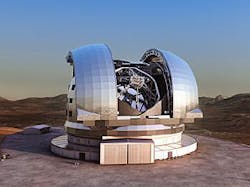ALPAO to supply high-order deformable AO mirror to Observatoire de Paris
Adaptive-optics (AO) components and systems maker Alpao (Montbonnot, France) will supply a high-order deformable AO mirror to Observatoire de Paris; the mirror will have more than 3000 actuators with bandwidths higher than 1000 Hz. The mirror will be used in experiments and preparation for the instrumentation of the European Extremely Large Telescope (E-ELT; Cerro Armazones, Chile), which, with its 39-m-diameter primary mirror, is the largest telescope in the world.
Observatoire de Paris specializes in astronomical ground-based and high-angular-resolution instrumentation. LESIA (Laboratoire d'études spatiales et d'instrumentation en astrophysique) and GEPI (Galaxies, Etoiles, Physique et Instrumentation), the two laboratories involved in this project, have led or have been major contributors to several instruments for the Very Large Telescope of the European Southern Observatory, such as FLAMES (Fibre Large Array Multi Element Spectrograph), NAOS (Nasmyth Adaptive Optics System), MIDI (Mid-infrared Interferometric instrument), SPHERE (Spectro-Polarimetric High-contrast Exoplanet Research), and Gravity.
LESIA and GEPI are now involved in the instrumentation of the coming E-ELT. LESIA is leading the French contribution to MICADO (1), the E-ELT first light imager, and GEPI is the PI institute of MOSAIC (2), the E-ELT multi-object spectrograph. The contract signed between Alpao and Observatoire de Paris aims at providing LESIA and GEPI a state-of-the-art deformable mirror, enabling Observatoire de Paris to strengthen its expertise in high-angular-resolution instrumentation and providing Observatoire de Paris with an essential piece of equipment for the MOSAIC and MICADO projects.
This procurement was made possible by the support of the Region Ile de France and its program DIM ACAV, as well as the support of the CNRS National Institute of Earth Sciences and Astronomy (INSU; Paris).
"This high-order deformable mirror is crucial equipment for us, since it will bring us important information for the choice of the deformable mirrors for MOSAIC and it will allow us to validate, in France, the performance of the first-light adaptive optics of MICADO," says Yann Clénet, a researcher at LESIA - Observatoire de Paris.
(1) The first-light imager MICADO (Multi-Adaptive Optics Imaging Camera for Deep Observations) is one of the two first-light instruments for the E-ELT. It will be the first dedicated imaging camera for the E-ELT. The instrument will work with a multiconjugate laser-guide-star AO system (MCAO, developed by the MAORY consortium) as well as a single-conjugate natural-guide-star AO system (SCAO, developed jointly by the MICADO and MAORY consortia under MICADO's responsibility). LESIA, in collaboration with GEPI, is responsible for the development of this single-conjugate adaptive optics (SCAO) mode of the instrument, as well as the high contrast imaging mode of the instrument.
(2) The multi-object spectrograph (MOSAIC) will be the workhorse instrument for the E-ELT. MOSAIC will contribute to all fields of contemporary astronomy, from extrasolar planets to the study of the halo of the Milky Way and its satellites, and from resolved stellar populations in nearby galaxies out to observations of the earliest "first-light" structures in the Universe. GEPI is the principal investigator institute leading the development of the instrument and LESIA is responsible for the development of its AO system.
About Alpao
Alpao designs and manufactures a range of adaptive optics products for use in research and industry. Alpao provides deformable mirrors, wavefront sensors, and software. With a background in astronomy, Alpao' s products are made for various applications such as ophthalmology, microscopy, astronomy, wireless optical communication,s and laser applications.
Source: Alpao
About the Author
John Wallace
Senior Technical Editor (1998-2022)
John Wallace was with Laser Focus World for nearly 25 years, retiring in late June 2022. He obtained a bachelor's degree in mechanical engineering and physics at Rutgers University and a master's in optical engineering at the University of Rochester. Before becoming an editor, John worked as an engineer at RCA, Exxon, Eastman Kodak, and GCA Corporation.

